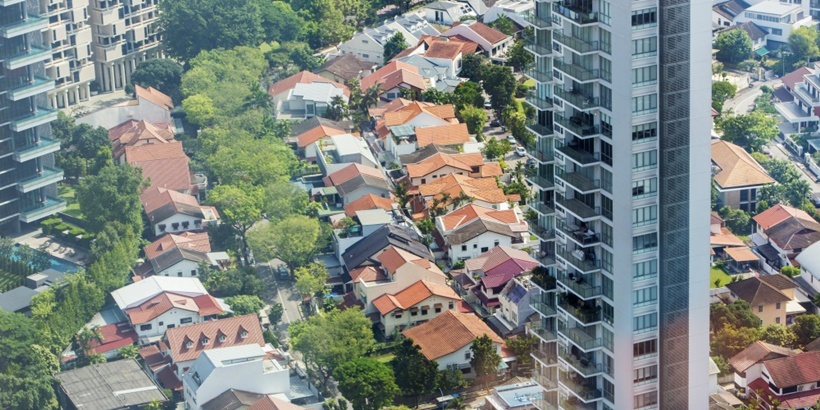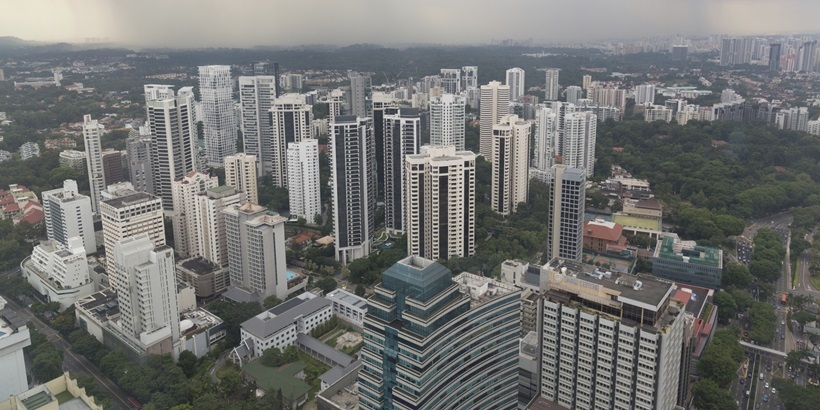There may be light at the end of the tunnel.
Last year’s real estate sales figures show the lowest drop in three years, a sign that the property market may be bottoming out.
In a publication on Singapore’s property sector released last month, Credit Suisse reported that resale volumes are up a robust 53 per cent year-on-year in the third quarter of 2016 and take-up rates at primary sales launches have been healthy.
Year-to-date, 51 per cent of total units were sold in the first month of project launch, a steady improvement from 31 percent in 2014. Total unsold units were at an all-time low of 22,502 units.
According to URA’s Q4 flash estimate released on Jan 3, home prices dropped for a 13th quarter, extending the longest losing streak on record, but with the slow decline easing in the last three months of 2016.
For the whole of last year, prices have fallen by 3 per cent, compared with the 3.7 per cent drop in 2015, URA said.
Market sentiments for pricatre homes, executive condominiums (EC) and HDB resale flats improved in 2016, resulting in a higher volume of transactions/
Signs of a pick-up
The positive sentiment is likely to carry through into 2017, says Mr Ong Teck Hui, national director, research & consultancy, Singapore, JLL.
“Sale of private homes by developers for 2016 is likely to be around 8,000 units, about 8 per cent higher than the 7,440 taken up in 2015,” says Mr Ong.
But while this is an improvement in demand, it is still nowhere near the strong transaction volumes before 2014.
“What this means is that it is still a buyer’s market, with many options available and ample time to scout around. A rapid turnaround is not expected as the
cooling measures are still in place and the economic slowdown could result in some buyers being more cautious,” he adds.
Lower private home prices
OrangeTee’s head of research and consultancy Wong Xian Yang predicts prices of landed homes to head south, as economic headwinds and loan curbs persist.
“However, volumes are expected to increase, as investors with deep pockets swoop in to pick up deals at attractive prices,” he says.
Mr Tay Kah Poh, executive director and head of residential services at Knight Frank, says prices of private residential properties could register price movements of -3 per cent to +1 per cent year-on-year in Q4 2017.
“Nevertheless, with pent-up demand possibly to be released from prospective buyers with bigger budgets, there could be pockets of opportunities for high-end and city fringe homes with lower price declines or marginal price recovery towards the later half of 2017,” he says.
On the HDB front, Mr Wong believes the market has pretty much stabilized, based on the stable movement of HDB resale prices in the past four quarters (Q4 2015-Q3 2016) and the increase in resale volume.
“The market is likely to follow a similar trend this year, with slight fluctuations in resale prices," he says.
“Latent demand in the resale et remains strong, and demand is expected to grow stronger on the back of stabilised prices. However, we are unlikely to see a strong recovery in prices any time soon, as loan curbs and the three-year PR ruling remains in place, putting a cap on demand,” he adds.
Bright Spots
A City Developments Limited (CDI) spokesman says based on its experience, suburban condominiums and ECs in excellent locations can expect to enjoy good demand.
Launched in October, CDL's
Forest Woods suburban condominium, which is a five-minute walk from Nex Shopping and Serangoon interchange and bus interchange, was the best-selling development for month. As at end-December 2016, 74 per cent of its total 519 units have been sold.
Asked which type of property offers the most promise in 2017 Mr Wong's bet is on ECs.
l would favour the EC market. EC pipeline supply remains low and they offer a value-for-money option for occupiers, given the price gap between comparable ECs and private condos and the availability of government grants," he says.
So far, only three new EC launches have been confirmed
The government's rules that prohibit-developers to launch EC units of Government Land (GIS) sites less than 15 months after a successful tender bid means that we can expect only three new EC launches this year, says Mr Jeremy Lee, co-founder and Chief technology officer of StreetSine Group.
One EC of note is
The Visionaire, a 99-year leasehold development that sets the stage for smart living, with features that enable home also to stay connected to smart appliances such as air-conditioners, lights and wireless speakers via their mobile devices.
Location and affordable pricing are still the main factors in real estate.
Knight Frank's Mr Tay says: "Buyers should always remember first principles – good locational attributes are key, although there must also be reasonable pricing match.
Mr Lee of StreetSine Technology Group adds: "Prospective buyers will prefer residential projects that are priced more favourably over other neighbouring developments."
The most important feature that Singaporean buyers favour in on property – be it for own occupation or investment – is proximity to a transport hub.
Says Mr Lee: “This is evidenced from residential projects that enjoyed strong take-up rates last such as
Forest Woods and
Lake Grande. The projects are all located in close proximity to MRT stations, which provide good transport connectivity to other parts of the island.
Unsurprising, being near good other lifestyle conveniences are also deal makers.
Several educational institutions - St. Andrew's Junior School and Bendemeer Primary School - are located within one kilometre of the development.
Apart from the vibrant retail shops and dining establishments at their doorsteps, residents will also enjoy easy access to a host of other amenities, including City Square Mall, Nex Shopping Mall, wet markets, supermarkets and food centres. There are also sports and recreational facilities including Bidadari Park, St. Wilfred Sports Complex, Toa Payoh Gold Range and SAFRA Toa Payoh, nearby.
Renters’ market
The rental market is expected to remain lacklustre in the year as supply continues to overwhelm demand, says Orange lee's Mr Wong.
This is largely due to the high volume of residential homes completed in recent years.
Mr Wong expects demand to remain capped due to the weak economic outlook and right foreign labour workforce.
According to
SRX Property Price index for non-landed private rentals, year-on-year, rents in November 2016 were down by 4.5 per cent from November 2015, and down 18.9 per cent down compared to its peak in January 2013.
Similarly on the IDB front, based on SRX Property Price Index for HDB year-on-year, rents in November 2016 were down by 4.6 from November 2015, and down 12.2 percent compared to its peak in August 2013.
Ms Juliann Teo, head of residential leasing, Singapore, JLL predicts rents in the prime districts to decline by approximately 6 to 8 per cent.
"Given the recent key economic indicators, turnaround in rents are not expected until Q1 2018. lf turnaround occurs, we expect it to be a gradual incline," she says.
JLL expects the vacancy rate for residential properties island wide to hover around 9 per cent. Although about 14,000 units are slated for completion this year, less than the approximately 22,000 units in 2016, not all will be for lease immediately.
“From the completions, we also expect non-prime district to account for more units than prime districts, translating into a larger pressure on suburban locations since expatriates cally prefer to reside in the prime districts," she adds
Landlords: exercise flexibility
In a soft rental market, having the right rental strategy can make a difference, says Mr Wong of OrangeTee.
“Investors should consider the entry yield, the ‘rentability' of the property and the associated maintenance costs,” says Mr Wong, adding that they should keep renovations simple to minimise initial capital outlay and understand which renovations value add to the property, he adds.
Choosing the right development, one that gives the highest yield and with an abundance of facilities and services, will naturally add premium to the rental rate, says Mr Vincent Ong, director of EVIA Real Estate Management, whose latest development
Gem Residences in Toa Payoh.
Mr Ong advises landlords to consider providing more services in their rental units as a point of differentiation.
Free Netflix, Internet, laundry and cleaning services are very appealing to tenants. In Gem Residences, free Internet and complimentary concierge services that on demand laundry and cleaning, as well as food delivery are available so that landlords don’t even need to pay extra to attract tenants,” he says.
t will also be in the landlord's best interest to minimise vacancy periods, says JLL's Teo.
"Tenant retention should be the key strategy if the property is already leased. Otherwise, forwarding lease renewal at an earlier before the lease expires will buffer the time required to seek a new tenant," she says.
“For vacant properties, given the high number of options available in the market, constant upkeep of the property to ensure a pleasant inspection experience by prospective tenants would be imperative says Ms Teo.
Holding power important
Analysts and property developers alike believe real estate will continue to be in demand, as part of any investment portfolio.
“Cyclical factors aside, it offers generally stable and decent risk-adjusted returns and is a good hedge against inflation,” says Knight Frank's Mr Tay.
The underlying demand for real estate is still firm as seen in buyers response to attractive projects, adds JLL's Ong.
“Local and regional wealth is significant and continues to drive demand for real estate in Singapore. Singaporeans also seem to have a preference for residential property investment, believing long-term capital gains compared to more volatile financial instruments," he says.
While signs may point to a more stabilised market, investors should always do their sums and not rush in, cautions Mr Wong of OrangeTee.
“One should always do his homework first and not rush into a property purchase, although there is now a slight urgency to make a decision as units are selling more quickly as compared to 2015.
But investors should bear in mind that the current global economy remains strewn with uncertainty, and should ensure that they have the holding power to last for the medium to long term,” says Mr Wong.
As published on TheStraitsTimes.
Source: SRX (11 Jan 2017)










